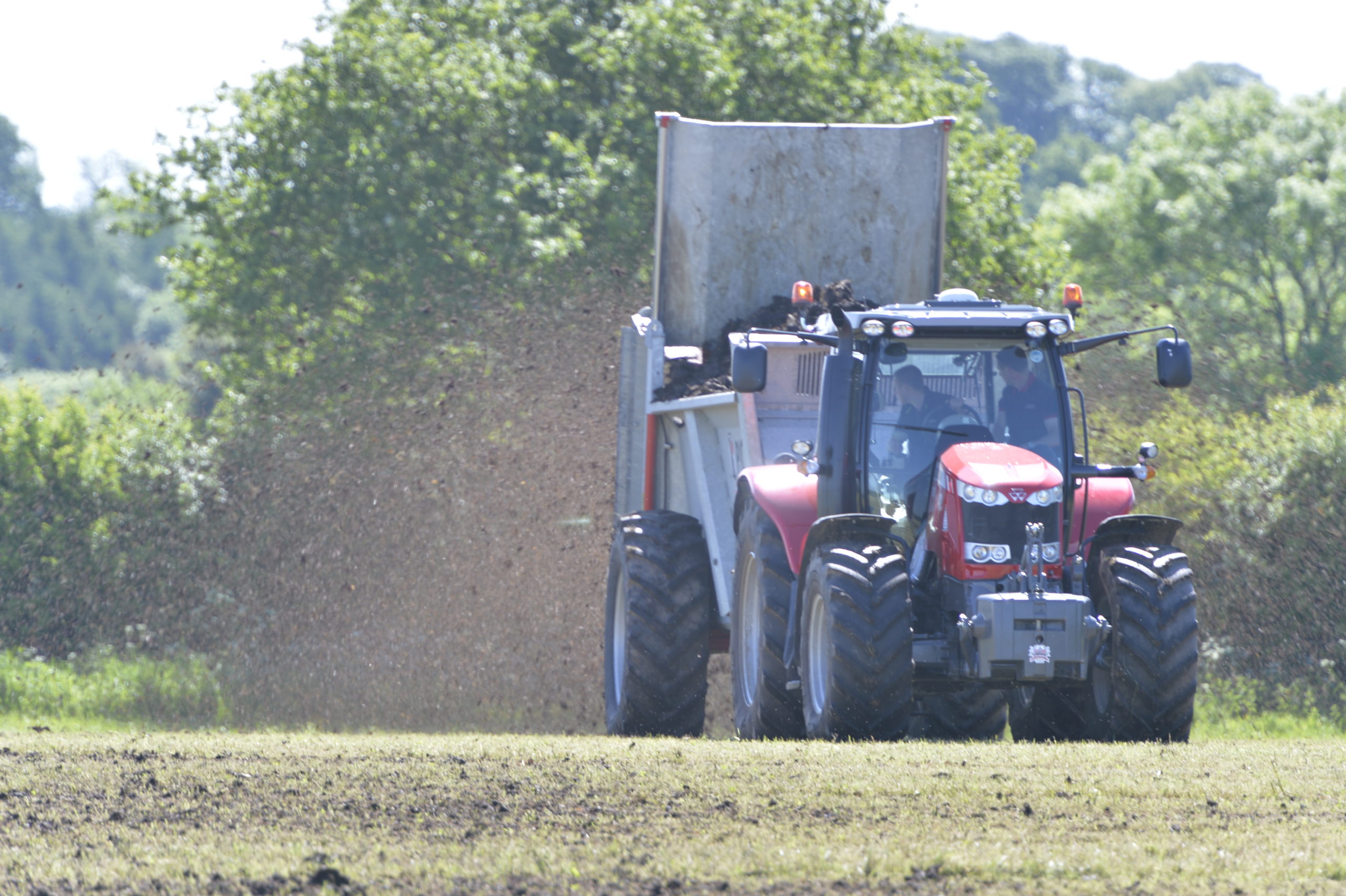By Michelle Nuttall, AHDB Knowledge Exchange Manager
Given soaring fertiliser prices and tightening regulations, it was timely to host a practical webinar on how to make the most of muck. At £451/ha in saved fertiliser cost for every 40t of cattle muck applied, the audience, understandably, listened intently.
AHDB’s Senior Scientist from the Environment team, James Holmes, joined me and Dr Lizzie Sagoo to provide clarity and guidance on the current rules and regulations. Dr Sagoo, ADAS’s Principal Soil Scientist covered an in-depth, yet practical, ‘how-to’ maximise nutrient content when using organic materials for crop nutrition.
Rules and Guidance on applying organic matter
Key reminders from Mr Holmes were that RB209 is for growers as guidance only, it’s Defra’s eight rules that are legislation, and, as we come into the winter months, it’s rule one that is of primary concern when it comes to spreading slurry and manures. Essentially, this rule is to protect water quality. It restricts growers to organic material applications in the autumn or winter only where the crop has a nitrogen requirement in the year ahead.
AHDB recently funded ADAS research to explore the implications of rule one. The work concluded that if all manure applications are moved to spring, nitrogen pollution could be reduced by 60%; however, both phosphate pollution and ammonia emissions are both likely to increase.
We’re working closely with Defra and the Environment Agency on how their rules – and our guidance – can evolve. We’re seeking a more sustainable solution which enables growers to make better use of resources while protecting water quality.
Value of organic materials
Dr Sagoo gave application advice to make the most of muck, starting with the value of different types of manure.
Applied at a rate of 40t/ha, the nutrient value of “typical” cattle muck has nearly doubled from £263/ha in spring 2020, to £451/ha more recently as a result of recent increases in fertiliser prices. Given its financial value, it’s well worth taking steps to minimise losses and maximise nutrient availability to crops.
But it’s complicated, particularly when it comes to nitrogen which can be lost through volatilisation, denitrification and nitrification. In recent decades there’s been lots of research into the factors affecting nitrogen loss and in developing strategies which minimise nutrient losses.
Optimising the nutrient value of manures and slurries – assessing the nutrient content
Step one is understanding the nutrient content of the organic material. While nutrient content can vary widely, there are a number of tools available to farmers, from laboratory and on-farm testing to data-based estimates. AHDB Nutrient Guide (RB209), for example, contains tables of “typical” crop nutrient availability figures for N, P K, Mg and S for various manures at different timings. The MANNER-NPK software tool is also useful, it provides estimates for crop available nitrogen, phosphate and potash, and is available to download at https://www.planet4farmers.co.uk/Manner.aspx
The guidelines in RB209 are useful, they have been drawn from a large number of samples, but they are averages and lots of factors impact nutrient content in organic materials. Livestock species, diet, bedding type and quantity, water use and how the manure or slurry has been stored will all effect nutrient levels. Laboratory testing will improve the accuracy of your nutrient management.
Dr Sagoo stressed the importance of obtaining representative samples by taking a number of sub-samples and mixing them. In the case of slurry, it means stirring, as the dry matter content settles during storage. It’s a factor to remember when it comes to application too; later loads from the bottom of stores often contain higher levels of dry matter and nutrients.
Optimising the nutrient value of manures and slurries – reducing leaching
When trying to minimise nitrogen losses, timing of applications, type of organic material, the amount of readily available nitrogen and soil type are all factors to consider.
Research shows nitrate leaching is higher when applications are made during the earlier autumn and winter months, as the amount of rainfall between the date of application and end of soil drainage in the spring is greater than for later winter/early spring applications. Leaching is highest for slurries and manures that contain a higher proportion of readily available nitrogen.
Leaching losses are generally greater from lighter textured sandy soils, however it’s a common misconception that clay soils are nutrient retentive and that cracks close up in the winter and spring. Cracks do shrink when clay soils wet-up, but they don’t close and readily available nitrogen is still at risk of leaching if applied shortly before a rain event.
To illustrate the point, Dr Sagoo showed results of trials at three experimental sites with hydrologically-isolated plots where drainage water could be captured and analysed. It revealed nitrate leaching was greater from autumn slurry applications in comparison with those made in winter or spring applications.
The trial also analysed ammonium, phosphate sediment and pathogen concentrations in drainage water. Ammonium and phosphate move differently through soils. They aren’t soluble and don’t tend to leach through the soil matrix, but will still travel through soils with water via a network of small cracks and channels to the drains. It means we see elevated levels in drains if there’s high rainfall shortly after applications to wet soils. In the trial, peaks of phosphate and ammonium levels were clear to see in the water taken from the drains.
ADAS’s work contributed to risk management guidelines which advise farmers of the relative risk of water pollution from slurry applications to drained clay soils based on soil moisture deficit at the time of application. Where the deficit is high >20mm, the risk of leaching is low, where the soil is wet and the deficit is low <10mm, the risk of leaching is high.
Optimising the nutrient value of manures and slurries – reducing volatilisation
A third of the readily available N can be lost through volatilisation.
It’s a significant loss pathway. Growers can mitigate losses when applying solid manures by incorporating the material, and through using precision application kit to apply liquid manures and slurry.
Trials show a trailing hose can reduce ammonia emissions by 30% in comparison with surface broadcast. A trailing shoe can reduce emissions by 40% and shallow injection, by 70%. For solid manures, ammonia emissions occur shortly after applications, so incorporating material soon after application has the greatest reduction in emissions.
Optimising the nutrient value of manures and slurries – phosphate, potash and sulphur
It’s not all about nitrogen, some manures and slurries are more valuable because of their phosphate and/or potash content. It is important to use them on fields that are low on these respective nutrients and cut back fertiliser applications accordingly.
As a guide, Dr Sagoo recommended growers follow advice in RB209 and use ‘available’ phosphate and potash figures where the soil index is 0 or 1, and ‘total’ phosphate and potash figures where the soil index is 2 or above.
AHDB has funded in recent years research into sulphur supplied by organic manures applied to wheat and OSR. The results have enabled the organisation to produce figures for sulphur availability for a range of organic materials and can be found in the Nutrient Management Guide.
Optimising the nutrient value of manures and slurries – farm nutrient management plan
The final step is to integrate the manure nutrients into the farm nutrient management plan and reduce bagged fertiliser use accordingly.
Optimising the nutrient value of manures and slurries – applications and organic matter
When it comes to application, it is important to know the application rate and to spread it evenly. Take the same care over your manure or slurry applications as you would your fertiliser applications.
As well as supplying crop nutrients, manures are also a good source of organic matter. A typical 40 t/ha application of cattle manure will apply about 5.5 t/ha of organic matter. Although it is difficult to put a financial value on the organic matter content of manures, there are studies which have shown tangible increases in soil quality following long-term use of organic materials.
How to make the most of muck, a summary
To maximise the value of organic materials, assess crop nutrient requirements using guides like RB209, target manure applications to fields that need nitrogen, phosphate and potash, estimate the nutrient content of the materials you’re applying, apply them accurately, evenly and at appropriate application rates, and take steps to minimise nutrient losses by leaching or volatilisation. Use a nutrient management plan to take account of the nutrients and reduce your bagged fertilisation use accordingly.
To watch the full webinar, click here
Other useful materials:
How to sample farmyard manure: https://youtu.be/p1s9NapwtaQ
How to sample slurry: https://youtu.be/MeFSwUHkz7g
-Ends –
For further information contact Rebecca Dawes, Jane Craigie Marketing via rebecca@janecraigie.com or 07792 467730

